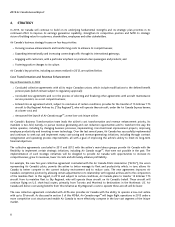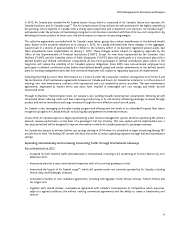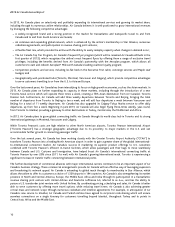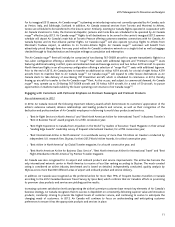Air Canada 2012 Annual Report Download - page 18
Download and view the complete annual report
Please find page 18 of the 2012 Air Canada annual report below. You can navigate through the pages in the report by either clicking on the pages listed below, or by using the keyword search tool below to find specific information within the annual report.2012 Air Canada Annual Report
18
Components of the year-over-year change in full year system passenger revenues included:
The 2.6% traffic increase which reflected traffic growth in all markets.
The 1.8% system yield improvement which reflected growth in all markets with the exception of U.S. transborder market
where U.S. short-haul routes continued to be impacted by increased industry capacity and aggressive competitive pricing
activities. The overall yield improvement was due to increased fares and higher fuel surcharges to partly offset higher fuel
prices, and gains in premium cabin traffic. The favourable impact of a weaker Canadian dollar on foreign currency
denominated passenger revenues was also a factor in the yield improvement, increasing revenues by $35 million year-
over-year.
The 3.2% RASM increase was due to the higher yield and a passenger load factor improvement of 1.1 percentage points. RASM
improvements were recorded in all markets with the exception of the U.S. transborder market.
Refer to section 7 of this MD&A for year-over-year percentage changes in passenger revenues, capacity, traffic, passenger load
factor, yield and RASM by quarter for the fourth quarter 2012 and each of the previous four quarters.
Domestic passenger revenues increased 4.1% from 2011
In 2012, domestic passenger revenues of $4,178 million increased $163 million or 4.1% from 2011, largely due to traffic
growth of 2.7%. The 1.0% domestic capacity increase reflected capacity growth on routes linking Toronto and Montreal, on
regional routes in Ontario, and on routes to the Maritimes.
Components of the year-over-year change in domestic passenger revenues included:
The 2.7% traffic increase which reflected traffic growth on all major domestic services.
The 1.2% yield increase which reflected yield growth on all major domestic services with the exception of routes linking
Toronto and Montreal and of regional routes in Ontario. These routes were adversely impacted by increased industry
capacity and aggressive pricing activities. The overall yield improvement was mainly due to fare increases, an
improvement in the proportion of higher-yielding passengers, primarily in the economy cabin, and a favourable currency
impact of $5 million.
The 3.0% RASM increase was due to a 1.4 percentage point improvement in passenger load factor and the higher yield.
U.S. transborder passenger revenues increased 3.2% from 2011
In 2012, U.S. transborder passenger revenues of $2,130 million increased $66 million or 3.2% from 2011 due to traffic growth
of 3.1% and an increase in baggage fee revenues. The 2.8% U.S. transborder capacity growth reflected an increase in
frequencies and/or the use of larger aircraft on routes to California, Florida, Hawaii and Las Vegas, and on U.S. short-haul
routes such as Boston, New York and Washington D.C.
Components of the year-over-year change in U.S. transborder passenger revenues included:
The introduction of a new baggage fee policy on U.S. transborder services effective October 27, 2011.
The traffic increase of 3.1% which reflected traffic growth on all major U.S. transborder services.
The 3.0% yield decrease which reflected the impact of increased industry capacity and competitive pricing activities,
particularly on U.S. short-haul routes such as Boston, New York and Washington, D.C. Partly offsetting the yield decrease
was a favourable currency impact of $11 million.
The 2.7% RASM decrease was primarily due to the lower yield. Baggage fee revenues are not included in Air Canada’s yield
and RASM results.
























